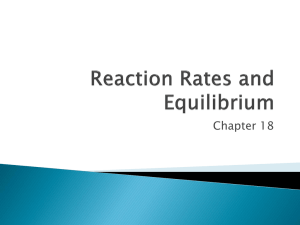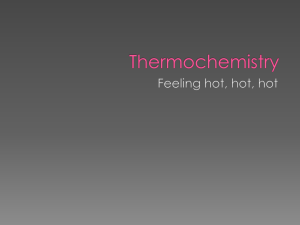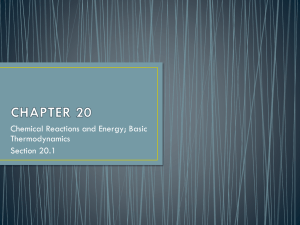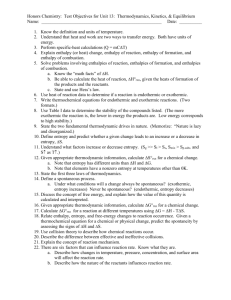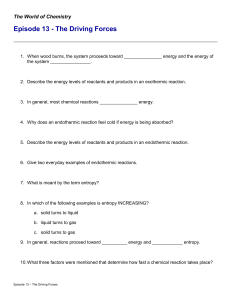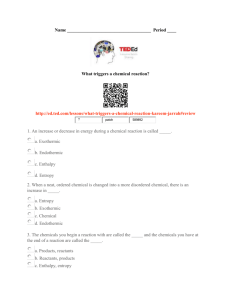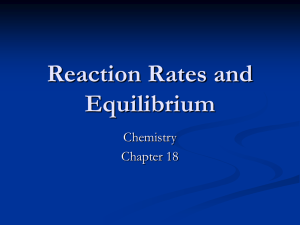Kinetics and Equilibrium HW
advertisement
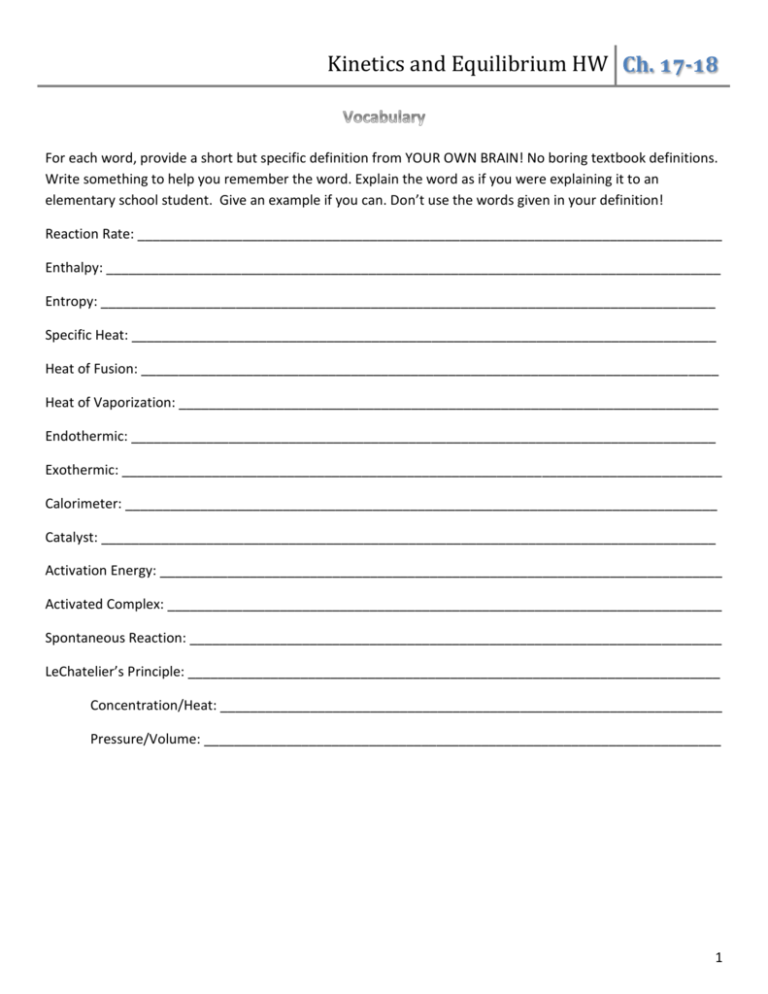
Kinetics and Equilibrium HW Ch. 17-18 For each word, provide a short but specific definition from YOUR OWN BRAIN! No boring textbook definitions. Write something to help you remember the word. Explain the word as if you were explaining it to an elementary school student. Give an example if you can. Don’t use the words given in your definition! Reaction Rate: ______________________________________________________________________________ Enthalpy: __________________________________________________________________________________ Entropy: __________________________________________________________________________________ Specific Heat: ______________________________________________________________________________ Heat of Fusion: _____________________________________________________________________________ Heat of Vaporization: ________________________________________________________________________ Endothermic: ______________________________________________________________________________ Exothermic: ________________________________________________________________________________ Calorimeter: _______________________________________________________________________________ Catalyst: __________________________________________________________________________________ Activation Energy: ___________________________________________________________________________ Activated Complex: __________________________________________________________________________ Spontaneous Reaction: _______________________________________________________________________ LeChatelier’s Principle: _______________________________________________________________________ Concentration/Heat: ___________________________________________________________________ Pressure/Volume: _____________________________________________________________________ 1 Kinetics and Equilibrium HW Ch. 17-18 Video 17.1 Reaction Rates Key Ideas: Collision theory states that a reaction is most likely to occur if reactant particles collide with the proper energy and ____________. The rate of a chemical reaction depends on several factors: temperature, concentration, nature of reactants, _______________, and the presence of a catalyst. More Notes: When the temperature of a reaction is _______________ the reaction rate increases and the reaction moves faster. This is a _______________ relationship. In order to make a reaction move faster, the concentration of the reactants can be _______________. This is a _______________ relationship. When substances in the solid phase react, it is best to ______________ the surface area of the reactants. This is a __________________ relationship. When substances are gaseous, increasing the pressure of the system will ________ the rate of reaction because particles will be closer together and collide more often. This is a ______________ relationship. Catalysts _________ the reaction rate by providing an alternate pathway for the reaction to take place. Ionic substances react ______________ than covalent substances due to their ability to quickly dissolve and switch ions. Questions: 1. Does every reactant collision result in a product being formed? Explain your answer. 2. How can we ensure more collisions will take place in order to increase the probability of a reaction? a. _______________________________________________ b. _______________________________________________ c. _______________________________________________ d. _______________________________________________ e. _______________________________________________ 3. Refrigerated food last longer than the same food left out at room temperature. Explain. 2 Kinetics and Equilibrium HW Ch. 17-18 Video 17.2 Enthalpy Review Notes: Enthalpy is a fancy word for __________ of reaction. All exothermic reactions are given a _____________ value on Table I. Exothermic reactions are ________ stable then endothermic reactions. Combustion reactions are the first 13 reaction on table I. What reactant do they have in common? ___ The last 6 reactions on table I show substances dissolving. What reactant do they have in common? __ Questions: 1. How can you determine if a reaction is endothermic or exothermic based on the sign of ΔH? 2. If a reaction is endothermic, is the heat a reactant or product? Explain. 3. Is the formation of aluminum oxide endothermic or exothermic? 4. Is the decomposition of nitrogen dioxide endothermic or exothermic? 5. Which is more stable: C2H6 or C2H4? Explain. 6. In the reaction where C2H2 is formed, which system has more energy, the reactants or the products? Fe2O3 + 3CO 2Fe + 3CO2 + 26.3KJ 7. How much heat is produced when 3.56 moles of CO are used? 8. How many moles of Fe are produced when 356KJ of heat are made? 9. How much heat is produced when 56.8grams of Fe2O3 are used? 3 Kinetics and Equilibrium HW Ch. 17-18 Video 17.3 Enthalpy Calculations Heat is a transfer of energy (usually thermal energy) from a body of ________________ temperature to a body of ______________ temperature. Thermal energy is the energy associated with the random motion of atoms and molecules. Temperature is a measurement of the average ________________________________ of the particles in a sample of material. Temperature is not a form of energy. The concepts of potential and kinetic energy can be used to explain physical processes that include: fusion (melting), solidification (freezing), vaporization (boiling, evaporation), condensation, sublimation, and ___________________. Exothermic reactions _______________ heat and have ______________ values. Endothermic reactions ______________ heat and have ______________ values. 1. Write the equation for the reaction on Table I that becomes the least stable: ____________________ 2. What type of reaction (endo or exo) is the dissolving of LiBr? _____________________________ 3. If 3 moles of C3H8 burn in oxygen, how many kilojoules of heat are released? (show work) 4. Define the following: q: _____________________________________ m: ____________________________________ c: _____________________________________ ΔT: ___________________________________ 5. Using q=mcT, calculate the following: (show work) a. How much heat is needed to raise the temperature of 50.0 grams of water 78C? b. How many grams of water can be heated 10C by the addition of 1000J? c. What is the specific heat of substance X if 1200J of heat are added to 25.0g of X and the temperature raises from 25 to 65C? 4 Kinetics and Equilibrium HW Ch. 17-18 Video 17.4 Enthalpy Calculations Continued (q=mHf and q=mHv) F D 1. On the diagram to the left, which line segment(s) can q=mcΔT be used? E 2. Which line segment(s) can q=mHf be used? 3. Which line segment(s) can q=mHv be used? B C A 4. Calculate the heat needed to change 25.0 grams of water from liquid to steam at 100C. (show work) 5. Calculate the heat needed to change 25.0 grams of water from ice to liquid at 0C. (show work) 6. Why aren’t the answers to questions 4 and 5 the same even though their substance and mass is the same? Video 17.5 Potential Energy Diagram Key Ideas: Energy released or absorbed by a chemical reaction can be represented by a ____________________ ______________ diagram. Energy released or absorbed during a chemical reaction (heat of reaction) is equal to the difference between the potential energy of the ____________ and the potential energy of the _________________. 5 Kinetics and Equilibrium HW Ch. 17-18 A catalyst provides an alternate reaction pathway, which has a______________ activation energy than an uncatalyzed reaction. More Notes: The _________ energy is the energy needed to start a reaction. It is labeled on the diagram with ____. The activated complex is the point with the _________ energy on the graph. It is labeled on the diagram with ____. The ________________ are always at the beginning of a reaction and is labeled here with a ____. The _______________ are always at the end of a reaction and is labeled here with a ____. The enthalpy of the reaction (or heat) is the _______________ between the products and the reactants and is labeled here with a ____. Reactions that have products with higher energy than reactants, such as the one in the diagram, are _______thermic reactions. Questions: 1. How much energy do the reactants have? 2. How much energy do the products have? 3. Is the reaction endothermic or exothermic? 4. What is the enthalpy value? 5. How much energy does the activated complex have? 6. How much energy does this reaction need to start (activation energy)? 7. If this reaction was reversed, how much activation energy would it need? 8. If this reaction was reversed, would it be endothermic or exothermic? 9. If this reaction was reversed, what would be the value of the enthalpy of reaction? 10. Draw what a catalyst would do to this reaction’s energy on the graph. 6 Kinetics and Equilibrium HW Ch. 17-18 Video 17.6 Entropy Notes: Entropy measures the ______________ in a system. The _______________ phase has the most entropy because its particles move the most. The more particles a system has, the __________ entropy it has. This is a direct relationship. In order for a reaction to be spontaneous it should have ____________ entropy and be _____ thermic which has a _________ (positive or negative) value. Questions: 1. Which substance has the highest entropy? a. Xe(g) b. S(s) c. Hg(s) 2. Which substance has the lowest entropy? a. H2O at -120˚C b. H2O at 0˚C c. H2O at 100˚C 3. When a system becomes less random the entropy a. Increases b. decreases c. remains the same 4. Which shows an increase in entropy? a. H2O(s) H2O(l) b. H2O(g) H2O(l) c. H2O(l) H2O(s) 5. The following reactions shows the entropy is a. Increases b. decreases CaCO3(s) CaO(s) and CO2(g) c. remains the same 6. The following reactions shows the entropy is a. Increases b. decreases 2AB 2A+B2 c. remains the same 7. A chemical reaction is spontaneous if a. There is a gain of energy and entropy increases b. There is a gain of energy and entropy decreases c. There is a loss of energy and entropy increases d. There is a loss of energy and entropy decreases 8. If a reaction is endothermic but still spontaneous the entropy must ___________________________ 7 Kinetics and Equilibrium HW Ch. 17-18 Video 18.1 LeChatelier’s Principle Key Ideas: Some chemical and physical changes can reach equilibrium. At equilibrium the rate of the forward reaction______________ the rate of the reverse reaction. The measurable quantities of reactants and products remain constant at equilibrium. LeChatelier’s principle can be used to predict the effect of___________ (change in pressure, volume, concentration, and temperature) on a system at equilibrium. Notes: Equilibrium states that a reversible reaction has equal _____________ not necessarily equal amounts. Equilibrium requires the rate that the reaction forms products must be ______________ the rate that the reaction forms reactants. When a reactant is added the reaction shifts away from the reactant to make more ______________. When a product is added the reaction shifts away from the product to make more _______________. When a reactant is taken the reaction shifts ___________ from the reactant to restore it. When a product is taken the reaction shifts ___________ from the product to restore it. When heat is added to a reaction the reaction shifts ______________ from the heat, much like a reactant or product. Therefore if heat is removed (or taken) the reaction shifts ______________ heat. When a gaseous system increases in pressure or decreases in volume the system can hold fewer moles. Therefore the reaction shifts towards the side with __________ moles. Questions: 1. Label where equilibrium is achieved in the system. 2. Write an equation for the system at equilibrium. 8 Kinetics and Equilibrium HW Ch. 17-18 3. In the equation: PCl5(g) + 100kJ PCl3(g) + Cl2(g) describe what happens to the chlorine when the following stressors are added to the system at equilibrium: a. b. c. d. e. f. g. h. i. j. k. PCl5 is added ________________ PCl3 is added ________________ PCl5 is removed ________________ PCl3 is removed ________________ Heat is added ________________ Heat is removed ________________ Pressure is added ___________ Pressure is relieved ___________ The volume of the chamber is decreased__ The volume of the chamber is increased __ A catalyst is added ___________ 9 Kinetics and Equilibrium HW Ch. 1718 10
